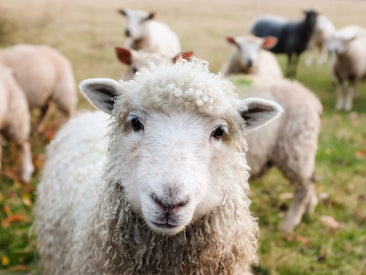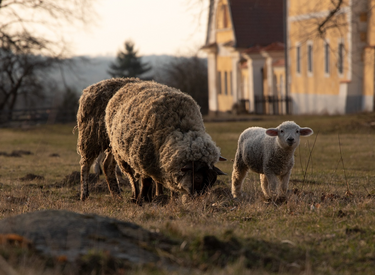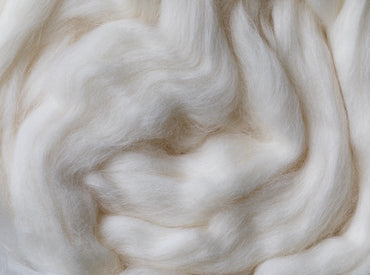Natural
Wool is a natural product that is shorn annually. It is naturally anti-microbial, wicks moisture, and regulates temperature - keeping you warm in winter and cool in summer.
Before we discuss why wool pillows are the finest choice for a natural pillow, let’s talk about the alternatives
Pillows made up of synthetic fibers have many names: “Down Alternative” “Memory Foam” or simply just “Pillow”. Any trend you see popping up of brightly colored pillows or pillows using patented material is produced from synthetics. Since the 1970s, synthetic fabric has taken the stage and has become the norm for what we wear and sleep on. Derived from petroleum, synthetic material such as polyester, polyurethane, and other plastics make up the vast majority of pillows today. These pillows have grown in popularity due to their shapeable nature and/or inexpensive price. These synthetic fibers are not only derived through chemical baths, but because of their incredibly flammable nature are required to be treated with various chemicals to reduce flammability.
Synthetic pillows contain flame retardants, formaldehyde, and benzene to name a few, all of which are found to be endocrine disruptors as well as carcinogenic. Because they are essentially plastic, synthetic pillows also shed microplastics which are absorbed into your skin and ingested into the body. This begs the question, should we be spending nearly a third of our lives on chemical plastic?
Down pillows are usually derived from the feathers of a goose. The feathers are either plucked from a dead bird in suboptimal conditions, or inhumanely plucked from a live goose. These feathers are usually stuffed in either a cotton or synthetic fabric case. While down pillows are more natural than their chemical alternative, they do have downsides. Besides likely coming from inhumane methods, goose down, as well as any bird feathers, are subject to mold and mildew.
When we sleep we sweat multiple ounces a night. Because feathers line the body of a bird in such a way to repel water, their orientation in a pillow sack allows them to become moist and thus produce mold and mildew. This can lead to allergies, asthma, and an overall strain on the immune system.
A growing health trend has been to use latex in pillows. The language gets confusing because there is a difference between latex and 100% natural latex. Regular latex usually contains synthetic material and other fillers as a binder, while 100% natural latex is derived from the rubber tree sap. Because the rubber tree sap is a liquid, the natural latex material needs to go a process called vulcanization, or a hardening of the rubber. This process requires 3-5% of zinc oxide and sulfur. While zinc oxide is thought to be safe, sulfur may cause respiratory issues. Latex is also known for its rubbery odor. While latex is not the worst of the pillow fill options, it’s best to avoid because of its uncertain and long supply chain manufacturing process.
Wool has been used by humans for thousands of years. It is a natural fiber that is sustainable, durable, and full of beneficial health properties. Wool has been shown to naturally regulate heart rate, keeping it low for a deeper sleep. It also purifies the air by binding to off-gassing VOCs in the air and destroying them at the molecular level Wool is also anti-microbial in nature, meaning it will not retain odor such as synthetic material does. This property protects sheep from mold, mildew, dust mites, and bacteria that would otherwise build up in their fleece. Wool has the incredible property of vacuuming moisture (in our case: sweat) to its core, and then heating it at the molecular level to naturally wick the moisture away. This makes wool one of the only naturally temperature regulating fibers in existence, keeping both you and the sheep warm in the winter and cool in the summer. Wool is also incredibly durable. While a strand of polyester fiber can bend around three-thousand times before breaking, wool fibers are so strong that it takes more than twenty-thousand bends before snapping. Our wool, however is carded into batts. Instead of clumping up like loose wool fill, our wool pillows will retain their shape because all the fibers are running the same direction. Unfortunately, not all wool is treated equally. The industry standard for wool is to treat it with a pesticide, boric acid, to keep insects such as moths away. Our wool, however, is free from any pesticides or chemical additives. It is protected from moths by being encased in our organic cotton pillow ticking. Our wool pillows are also entirely sustainable. Wool is grown annually by sheep from the grass they eat, the sunlight they receive, and the water they drink. While a synthetic pillow is produced with chemicals and will stay in landfills for hundreds of years before being broken down, our organic cotton and wool is naturally compostable and would decompose within a year if left back to the earth. Why wool pillows? Because wool is the most incredible fiber on the planet that science cannot replicate!
At The Woolshire we encase our wool in a tightly woven cotton pillow ticking that does not allow any wool to escape. The cotton is long-staple, certified organic, and grown by Texas family farms. It is the most quality cotton that is grown organically, which makes it more expensive to grow and cultivate. Nevertheless, our growers and weavers are dedicated to the craft of producing some of the finest cotton in the world.
What is organic cotton and how is different than conventionally grown cotton? If we aren’t consuming it, do we really need to be worried about choosing a fabric that is grown organically? Does it really make a difference to my health if my cotton pillow case is organic?
93% Of conventional cotton grown in the US is genetically engineered and contains an insecticide in the genetic makeup of the cotton plant. This insecticide cannot be washed out and thus is engrained in the cotton fabric. It was thought that by genetically engineering an insecticide into the cotton plant there would be less need for spraying pesticides, but this has proved to be false. More pesticides are being sprayed on cotton than ever before. Today cotton is the leading crop for pesticide use. Only taking up 2.5% of the earth's agricultural land, cotton accounts for 16% of all pesticide use.
"Organically grown cotton" is readily available through countries such as China and India, but unfortunately there is no regulation in the fabric industry to confirm the authenticity. There is also virtually no penalty in place for lying about the authenticity of organic cotton fabric. What has been found is that the vast majority of "organic cotton" from China and India is in fact not organic, usually genetically engineered, and contains a heavy amount of pesticides. Conventionally grown cotton also is found to contain formaldehyde, a carcinogen, to reduce wrinkles.
We make our organic cotton pillow cases from un-dyed long-staple cotton, sourced from the USA, which is certified organic through the USDA as well as a third party certifier, the Global Organic Textile Standard (GOTS). Our cotton is grown the way nature intended without the use of pesticides and free from genetic modification. It is free from formaldehyde or any chemical adulteration. It is also long-staple, meaning the cotton that we use for our pillow covers has been cultivated to perfection since the beginning of cotton growing in the United States. Sourcing organic cotton from the USA also supports Texas family farms that choose to continue to represent the 0.2% of organically grown cotton in the US.
At The Woolshire we do not compromise quality for the sake of cost. We believe that supporting local farms is at the core of who we are and we are dedicated to using these locally grown materials to the glory of God.

Wool is a natural product that is shorn annually. It is naturally anti-microbial, wicks moisture, and regulates temperature - keeping you warm in winter and cool in summer.

Wool is organic and completely biodegradable, making it an excellent material for sustainability.

Wool purifies the air by removing volatile organic compounds (VOCs) such as formaldehyde in the atmosphere.